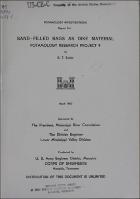Please use this identifier to cite or link to this item:
https://hdl.handle.net/11681/3164| Title: | Sand-filled bags as dike material : Potamology Research Project 9 |
| Authors: | United States. Mississippi River Commission United States. Army. Corps of Engineers. Lower Mississippi Valley Division United States. Army. Corps of Engineers. Memphis District Easley, Robert T. |
| Keywords: | Potamology Mississippi River Bank stabilization River banks Bank erosion Dikes Sand-filled bags Forked Deer, Tennessee |
| Publisher: | U.S. Army Engineer Waterways Experiment Station. Engineer Research and Development Center (U.S.) |
| Series/Report no.: | Potamology investigations report ; 21-1. |
| Description: | Potamology Report Summary: As the channel stabilization project on the Lower Mississippi River has progressed, the requirement for materials suitable for placement in deep water and swift currents has increased. Stone has met this demand for dike construction in the past, but other materials which might be better or more economical are being investigated. This report presents a description of field and office investigations of the use of one of these materials, sand- filled nylon and plastic bags, as dike material. Bags were substituted for stone in a short section of a stone dike being constructed at Forked Deer, Tennessee. The test section was so located that it was subjected to severe current and wave attack during and after placement. Placing was satisfactory, the bags remaining generally where placed in the swift current. There was some breakage of the bag material during mechanical handling, but this could be eliminated by improved handling methods. Inspection after a high-water period, during which the dike was subjected to fluctuating river stages above and below the top elevation of the dike, revealed that many of both types of bags on the surface of the structure had been ruptured and the fill material lost. This was attributed to drift to which the structure was subjected during the lower river stages. Some of the plastic bags had been moved by the current, but there was no evidence of any appreciable displacement of intact nylon bags. It was concluded that plastic bags are not suitable for use in dike construction because of the weakness of the material, requiring the use of smaller bags. Results indicated, however, that sand-filled nylon bags are superior to stone for use in making closures or for initial placing in swift currents, but would require an armor of stone or other material where exposed in permanent structures. |
| Rights: | Approved for public release; distribution is unlimited. |
| URI: | http://hdl.handle.net/11681/3164 |
| Appears in Collections: | Potamology Investigations Report |
Files in This Item:
| File | Description | Size | Format | |
|---|---|---|---|---|
| Potamology-Investigations-Report-No-21-1.pdf | 11.33 MB | Adobe PDF |  View/Open |